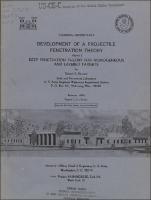Please use this identifier to cite or link to this item:
https://hdl.handle.net/11681/20590Full metadata record
| DC Field | Value | Language |
|---|---|---|
| dc.contributor.author | Bernard, Robert S. | - |
| dc.date.accessioned | 2017-01-11T18:50:26Z | - |
| dc.date.available | 2017-01-11T18:50:26Z | - |
| dc.date.issued | 1976-02 | - |
| dc.identifier.uri | http://hdl.handle.net/11681/20590 | - |
| dc.description | Technical Report | - |
| dc.description | Abstract: Existing shallow penetration theory (which is based on cavity expansion theory) is modified and extended for application to deep penetration in homogeneous and layered targets. This is accomplished by means of a postulated relation between the target penetration resistance and the so-called "solid Reynolds number." The predictions of the modified theory are shown to be in approximate agreement with experimental, empirical, and two-dimensional finite-difference results for shallow as well as deep penetration in metal, rock, concrete, and cohesive soil targets. | - |
| dc.publisher | Soils and Pavements Laboratory (U.S.) | - |
| dc.publisher | Engineer Research and Development Center (U.S.) | - |
| dc.relation | http://acwc.sdp.sirsi.net/client/en_US/search/asset/1045149 | - |
| dc.rights | Approved for public release; distribution is unlimited. | - |
| dc.source | This Digital Resource was created in Microsoft Word and Adobe Acrobat | - |
| dc.subject | Projectile penetration | - |
| dc.subject | Soil mechanics | - |
| dc.subject | Numerical models | - |
| dc.subject | Mathematical models | - |
| dc.title | Development of a projectile penetration theory. Report 2, Deep penetration theory for homogeneous and layered targets | - |
| dc.type | Report | en_US |
| Appears in Collections: | Technical Report | |
Files in This Item:
| File | Description | Size | Format | |
|---|---|---|---|---|
| TR-S-75-9-Report-2.pdf | 5.29 MB | Adobe PDF |  View/Open |